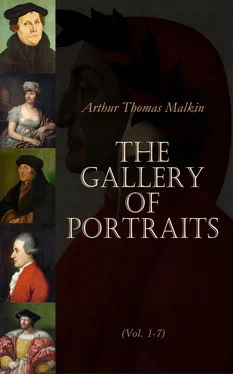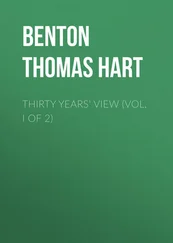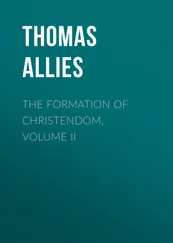After a residence of two years at Rome, Titian returned to Venice, taking Florence in his route. The first work on which he engaged after his return, was a picture of the Marquis del Vasto haranguing his troops. He likewise began some altar-pieces, but finished little, being summoned in 1550, by the Emperor Charles, to Vienna. The princes and ministers assembled at the Imperial Court were astonished at the confidence with which Titian was honoured by the Emperor, who gave him free access to his presence at all times, a privilege extended only to his most intimate friends. The large sums which the Emperor frequently sent him, were always accompanied with the courteous assurance that they were meant to testify the monarch’s sense of his merits, not in payment for his works, those being beyond all price. On one occasion, while the Emperor was sitting for his portrait, Titian dropt a pencil; the monarch picked it up, and presented it to him, saying, on Titian’s apologizing in some confusion, “Titian is worthy to be served by Cæsar.” The same jealous feeling which had been evinced towards him at Bologna, again manifested itself; but the artist, who amidst his loftier studies had not neglected the cultivation of worldly knowledge, found means to obviate envy, and to conciliate, by courtesy and presents, the good will of the whole court. It was at this time that Charles, sated with glory and feeling the advances of infirmity, began to meditate his retreat from the world. This intention, it is said, he imparted to Titian, with whom he delighted to confer concerning the arrangement of a large picture, which he then commissioned the artist to paint, and which he intended to be his companion in his retirement. The subject was an apotheosis, in which Charles and his family were to be represented as introduced by Religion into the presence of the Trinity. At Inspruck, whither he accompanied the Emperor, Titian painted a superb picture, in which Ferdinand, King of the Romans, and his Queen Anna Maria, are represented with the attributes of Jupiter and Juno, and round them are the seven princesses, their daughters. From each of these illustrious ladies, Titian received a jewel each time they sat to him. Here also he collected portraits for the apotheosis.
On the Emperor’s departure for Flanders, Titian returned to Venice; where, soon after his arrival, he offered to finish the works which were wanting in the great hall of the council. This offer was cordially accepted by the Senate; and he was empowered to select the artists whom he thought best qualified to be his coadjutors. He nominated Paul Veronese and Tintoret, nor did those great painters feel themselves humiliated in working under his directions. In 1553 the Emperor Charles returned to Spain, and being at Barcelona, nominated Titian a Count Palatine of the empire, with all the privileges, authority, and powers attached to that dignity. He also created him a Knight of the Golden Spur, and a noble of the empire, transmitting the dignity to his legitimate children and descendants. Crowned with these honours, and with faculties scarcely impaired, Titian had now reached his seventy-fifth year; and it would be difficult to select a man the evening of whose life has been more fortunate and happy. He still found in the practice of his art a source of undiminished pleasure; his works were sought by princes with emulous avidity; he was considered the chief ornament of the city in which he dwelt. He was surrounded by friends distinguished by their worth or talents; he had acquired wealth and honour sufficient to satisfy his utmost ambition; and he was secure of immortal fame!
But at this period, to most men one of secession from toil, Titian engaged in new undertakings with as much alacrity as if life were still beginning, and the race of fortune still to run. He enriched Serravalle, Braganza, Milan, and Brescia, with splendid works, besides painting a great number for the churches of Venice, for different noblemen, and for his friends. Philip II. of Spain showed no less anxiety to possess his works, than Charles, his father, had done: and nowhere perhaps, not even in Venice, are so many of his pictures to be found, as in the palaces of Madrid and the Escurial. When Rubens was in Spain, he copied Titian’s picture of Eve tempting Adam with the fatal fruit, nobly acknowledging that he had only made a Flemish translation of an elegant Italian poem. It is said by some of Titian’s biographers, that he himself made a visit to Spain; but this has been clearly disproved. The most important works which he executed for Philip II. are the pictures of the Martyrdom of St. Lorenzo, and the Last Supper. In the first, three different effects of light are admirably expressed; the fire which consumes the saint, the flame of a tripod placed before a pagan deity, and the glory of a descending angel. This picture is said to be equal to any of his earlier productions. The Last Supper betrays signs of a feebler execution, which is, however, atoned for by more than usual purity of design. Titian in this work partially imitated Lionardo da Vinci, but in the spirit of congenial feeling, not as a plagiarist. To this picture, which he began at the age of eighty, he devoted the labour of nearly seven years. For Mary of England, Philip II.’s consort, he painted four mythological subjects, Prometheus, Tityus, Sisiphus, and Tantalus, the figures as large as life, and conceived in the highest style of grandeur.
In 1570 died Sansovino the sculptor. Aretine had paid the debt of nature some years before, an event which sensibly affected Titian; and this second loss plunged him into such affliction, that his powers, it is said, from that time perceptibly gave way. We learn, however, from Ridolfi, that the Transfiguration on Mount Tabor, which he saw when in good condition, was ably executed. Some visions from the Apocalypse, in the monastery of St. John, painted about the same time, exhibit vivid imagination and fine colouring.
Henry III. of France, being in Venice in 1574, paid Titian a visit, accompanied by a numerous train. The venerable artist, then in his ninety-fifth year, received the monarch with dignified respect; his fine person was scarcely touched by decrepitude, his manners were still noble and prepossessing. In a long conversation with the King, he adverted, with the complacency natural to an old man at the close of so splendid a career, to honours which he had received from the Emperor Charles and King Ferdinand. When Henry, in walking through the galleries, demanded the prices of some of the pictures, he begged his Majesty’s acceptance of them as a free gift. In the mean time the courtiers and attendants were entertained with a magnificence, which might have become the establishment of a great prince.
Titian had nearly attained his hundredth year, when the plague, which had been raging some time in Trent, made its appearance in Venice, and swept him off, together with a third part of the inhabitants, within three months. He was buried in the church of the Frari; but the consternation and disorders prevalent at such a period, prevented his receiving those funeral honours which would otherwise have attended him to the tomb.
In comparing Titian with the great artists of the Roman and Florentine schools, it has been usual to describe him as the painter of physical nature, while to those masters has been assigned the loftier and exclusive praise of depicting the mind and passions. The works on which Titian was most frequently employed, appertaining to public edifices and the pomp of courts, were certainly of a class in which splendid effect is the chief requisite; but can it be said that the painter of the Ascension of the Virgin, and the S. Pietro Martire, was unequal to cope with subjects of sublimity and pathos? May it not be asked with greater justice, on the evidence of those pictures, whether any artist has surpassed him in those qualities? Even in design, on which point his capacity has been especially arraigned, Titian knew how to seize the line of grandeur without swelling into exaggeration, and to unite truth with ideality. Of all painters he was most above the ostentation of art; like Nature herself, he worked with such consummate skill that we are sensible of the process only by its effect. Rubens, Tintoret, Paul Veronese, were proud of their execution; few painters are not—but the track of Titian’s pencil is scarcely ever discernable. His chiaroscuro, or disposition of light and shade, is never artificially concentrated; it is natural, as that of a summer’s day. His colouring, glorious as it is, made up of vivid contrasts, and combining the last degree of richness and depth with freshness and vivacity, is yet so graduated to the modesty of nature, that a thought of the painter’s palette never disturbs the illusion. Were it required to point out, amidst the whole range of painting, one performance as a proof of what art is capable of accomplishing, it is surely from among the works of Titian that such an example would be selected.
Читать дальше












